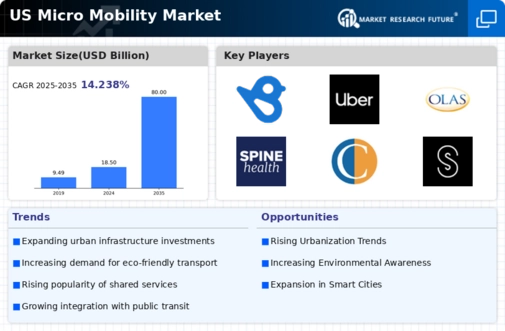Urbanization and Population Density
The increasing trend of urbanization in the United States is a pivotal driver for the micro mobility market. As more individuals migrate to urban areas, the demand for efficient and convenient transportation options rises. In densely populated cities, traditional transportation methods often become congested, leading to a growing preference for micro mobility solutions such as e-scooters and bikes. According to recent data, urban areas are projected to house approximately 85% of the US population by 2030, which could further fuel the micro mobility market. This shift not only enhances accessibility but also encourages the adoption of eco-friendly transportation alternatives, thereby aligning with the broader sustainability goals of urban planners and policymakers. Consequently, the micro mobility market is likely to experience substantial growth as urban centers adapt to these demographic changes.
Technological Integration and Innovation
Technological advancements play a crucial role in shaping the micro mobility market. The integration of smart technologies, such as GPS tracking, mobile applications, and IoT connectivity, enhances user experience and operational efficiency. For example, real-time tracking allows users to locate available scooters or bikes quickly, while mobile apps facilitate seamless payment processes. Furthermore, innovations in battery technology are extending the range and efficiency of electric scooters, making them more appealing to consumers. As technology continues to evolve, the micro mobility market is expected to benefit from improved safety features and enhanced user interfaces, potentially attracting a broader audience. The ongoing investment in technology by companies within the micro mobility market suggests a promising future for these solutions as they become increasingly integrated into urban transportation networks.
Environmental Awareness and Policy Support
Growing environmental awareness among consumers is significantly influencing the micro mobility market. As individuals become more conscious of their carbon footprints, there is a marked shift towards sustainable transportation options. This trend is further supported by local and state governments implementing policies that promote the use of micro mobility solutions. Incentives such as subsidies for e-scooter programs and the establishment of dedicated bike lanes are becoming more common. For instance, cities like San Francisco and New York have introduced regulations that encourage the use of electric scooters and bikes, thereby fostering a conducive environment for the micro mobility market. This alignment of consumer preferences with policy initiatives is likely to propel the growth of the micro mobility market, as more individuals opt for eco-friendly transportation alternatives.
Shift in Consumer Behavior and Preferences
The evolving preferences of consumers are a significant driver for the micro mobility market. As urban dwellers seek more flexible and convenient transportation options, there is a noticeable shift away from traditional car ownership. The rise of the sharing economy has also contributed to this change, with many individuals opting for on-demand services rather than committing to long-term vehicle ownership. Data suggests that around 60% of millennials prefer using shared mobility services over owning a car. This trend is particularly pronounced in urban areas, where the convenience of accessing e-scooters and bikes aligns with the fast-paced lifestyle of city residents. As consumer behavior continues to evolve, the micro mobility market is poised to capitalize on these changing preferences, potentially leading to increased adoption and usage of micro mobility solutions.
Cost-Effectiveness of Micro Mobility Solutions
The economic advantages associated with micro mobility solutions are becoming increasingly apparent, driving growth in the micro mobility market. With rising fuel prices and maintenance costs for traditional vehicles, consumers are seeking more affordable alternatives. E-scooters and bike-sharing programs offer a cost-effective means of transportation, often costing users significantly less than owning and operating a car. For instance, studies indicate that using a scooter can save individuals up to $1,000 annually compared to car ownership. This financial incentive is particularly appealing to younger demographics, including students and young professionals, who are more inclined to utilize micro mobility options. As the cost of living continues to rise in urban areas, the micro mobility market is likely to expand as more individuals recognize the economic benefits of these alternatives.

















Leave a Comment